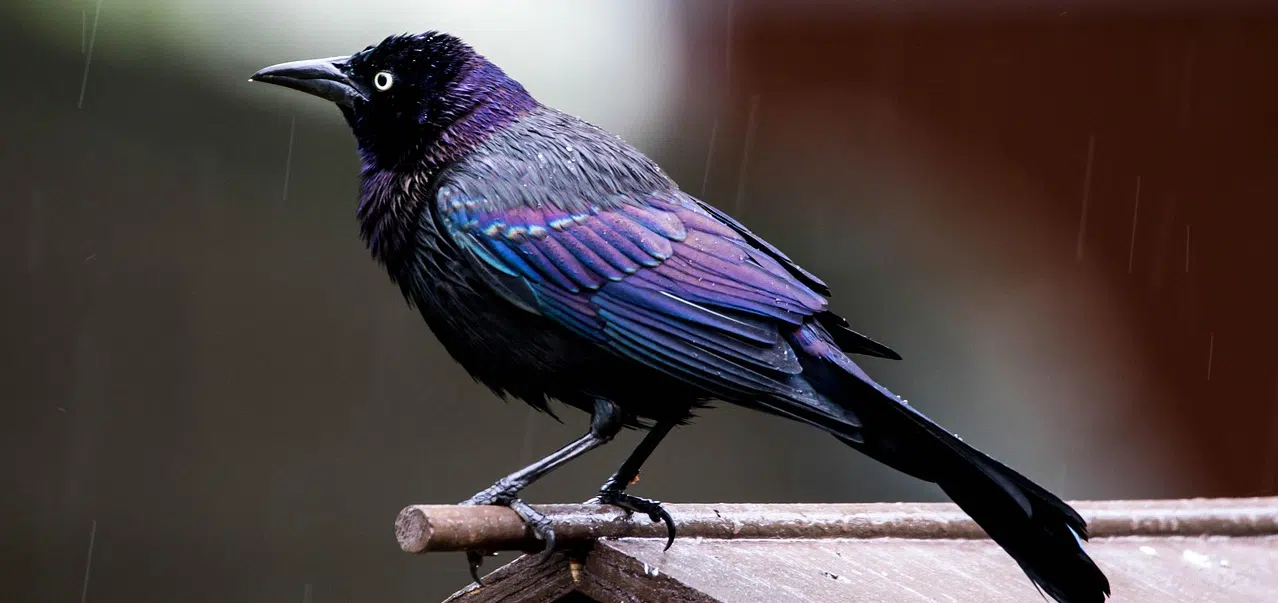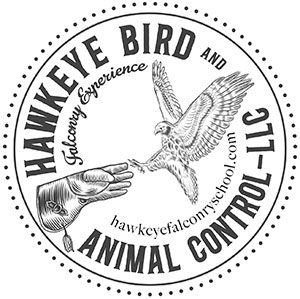
- Grackles are often considered pest birds due to their loud vocalizations, aggressiveness, large congregating groups and the mess they leave behind with their droppings.
- Grackles are frequently a nuisance at restaurant patios and resorts - they steal food from peoples' dinner plates and leave their droppings on people and their tables.
- Grackles are known to raid farm crops, particularly corn and other grains.
- Flocks of grackles are called a plague.
- Grackles are quite intelligent and have been seen using tools to crack open hard nuts to get the seed inside, much like crows do.
- Grackles can imitate sounds, including human speech and mechanical noises.
- They play a beneficial role in the ecosystem as grackles help control the insect populations and are a part of the food chain.
Grackle Classification
Grackles are an interesting classification of birds that are part of the songbird group, the Icteridae family, which also includes orioles, blackbirds, cowbirds and meadowlarks. These medium sized birds have a beautiful iridescent plumage, aggressive behaviour, and are very adaptable to the environment they are in. They are found mainly in North and Central America, in cities, urban area, country settings, especially wetlands and agricultural area. In spite of their sometimes contentious reputation, these birds play an important role in the ecosystems they live in.
Physical Characteristics of 3 Common Types of Grackles
Grackles in general are very dark, almost black, with shades of purple, blue, or green that can seem to vary depending on the light. Grackles' iridescent feathers are visible on the ultraviolet spectrum that makes their coloring almost shimmer in the light. They actually also display colors that humans cannot see. This allows them to use the coloring to communicate and for mate selection. Many birds see on the ultraviolet wavelengths and the intensity of coloration can indicate the health and vitality of a mate.
Males are larger than females and usually more colorful. This is a common trait among most birds species. Females tend to be a dark chocolate brown on their back with a lighter brown underbelly and a stripe above their eyes. The grackles strong feet and legs allow them to forage more efficiently on the ground and in the trees. There are 11 different types of grackles, this article will focus on the 3 most common types in North America.
The common grackle is 11 to 14 inches in length and a wingspan of 14 to 18 inches. they weigh about 2 1/2 to 5 ounces. They have a long keel shaped tail that is almost half as long as their body. They are found across North America east of the Rocky Mountains. The northern most grackles migrate south for the winter although they don’t move very far south, for the most part.
The boat-tailed grackle is larger - 10 to 17 inches in length (depending on sex), with a wingspan of 15 to 19 inches. The average weight is about 4 ounces for a female and up to 9 ounces for a male.
They are commonly found in the Southeast coastal regions and throughout the Florida peninsula. They also have a long keel shaped tail that is about half the length of their body.
The great-tailed grackle is larger still - 15 to 18 inches long with a wingspan of 19 to 23 inches, and again, the males are larger than the females, weighing in at 9 1/2 ounces for the males and 5 ounces for the females. They have a longer tail and a flatter crown than the smaller grackles. They are commonly found all over North and South America. They are also known as Mexican grackles.
Habitats
Common grackles live in wetlands, open woodlands and marshes as well as urban and suburban areas, in parks and agricultural fields. Boat-tailed grackles prefer coastal marsh areas, beaches and areas near the coast. They will also live inland in Florida where there are many ponds, lakes and marshy areas. Great-tailed grackles prefer groves, thickets, farms, city parks. They can be found in open and semi open country, including farmlands, irrigated fields and suburban lawns and golf courses. Grackles are highly adaptable and can make their home almost anywhere there is food and water for them. They are able to survive, and even thrive, in various and diverse environments. They are commonly found in parking lots, parks, beaches and suburban lawns where they scavenge for food.
Grackle Diet and Feeding Behavior
 Grackles or resourceful foragers and will eat almost anything food wise. They have a varied diet and will eat insects, fruits, grains, even human food scraps. They have been seen following agricultural plows to catch mice and small invertebrates. They will walk into shallow water to catch fish, leeches, small crabs. They will raid other birds nests and eat the eggs and hatchlings, sometimes even the adult birds. They can rip open garbage bags to eat food scraps and leave a mess behind. Such a varied diet makes them very opportunistic and very successful in almost any environment, both natural and urban.
Grackles or resourceful foragers and will eat almost anything food wise. They have a varied diet and will eat insects, fruits, grains, even human food scraps. They have been seen following agricultural plows to catch mice and small invertebrates. They will walk into shallow water to catch fish, leeches, small crabs. They will raid other birds nests and eat the eggs and hatchlings, sometimes even the adult birds. They can rip open garbage bags to eat food scraps and leave a mess behind. Such a varied diet makes them very opportunistic and very successful in almost any environment, both natural and urban.
Many people leave their food and garbage out, or even toss scraps or seeds out for the birds to feed on. Grackles, in particular, are bullies and will push out smaller species to get at the food, and their loud aggressiveness can be annoying. Do not feed the birds!
Social Behavior, Breeding and Nesting of Grackles
Grackles are very social birds that often form large flocks, or “plagues”, that can number into the thousands of birds. Their loud and aggressive behavior , especially in large numbers, helps them avoid predators and allows them to forage more effectively. Grackles can communicate with each other through an elaborate range of chattering, whistles and calls. They exhibit cognitive skills that allow them to negotiate social interactions very effectively. They are territorial and will attack other grackles that come into their territory.
Male grackles will engage in elaborate dance, puffing up their feathers and spreading their tails to display their bold ultraviolet spectrum coloring that will attract a mate. Males will sing frequently during breeding season to attract a female. Females will build the nests, usually in trees, sometimes shrubs, or even man made structures, using twigs and mud layering a softer bed of grass inside the nest. The finished nest is 6 to 9 inches across and 3 to 9 inches deep. The bigger the species of grackle the bigger the nest. They typically lay 3 to 5 eggs in a season and the incubation time is around 14 days. The young are able to leave the nest in 16 to 21 days. Male grackles are not monogamous and will typically not stay with their mate much longer than a nesting season. They do stick around and help defend the nest and hatchlings until they learn to fly and leave the nest. Both sexes incubate the eggs and feed their hatchlings - mostly insects.
Benefits and Drawbacks of Grackles
Beneficial to the Ecosystem
Because grackles help control the insect population they play a beneficial role in the ecosystem. Grackles help spread seeds from their droppings of the fruit and seeds they eat, so they can actually help plant trees, shrubs, and fruit seedlings. Grackles are part of the food chain, they eat smaller birds and animals (mice and small invertebrates), and they are eaten by other animals and birds of prey.
Insect Control
Grackles eat the insects that can damage crops and plantings, but they also like the seeds and grains of those crops. But, they are also known to cause significant agricultural damage.
Pushy and Aggressive
Grackles are bullies and can be very aggressive, pushing out other species of birds from forage areas, taking over bird feeders, and leaving a mess behind.
Messy
They can be picky eaters, only taking the choicest seeds and grains and leaving the rest on the ground.
Conflicts with Humans
Health Concerns
Grackles, like any bird species, can and do carry diseases. There are over 60 diseases that are carried by birds on their bodies, their feathers, and in their droppings. Because grackles are often congregating in very large flocks, their droppings can become quite dangerous for humans. Dried droppings become airborne just by walking near them and the particles are easily inhaled by humans, pets and other wildlife. People who are immunocompromised or frequently exposed to droppings can become very ill.
** Caution **
It is imperative that cleaning up dried bird droppings includes proper disinfectants and wearing personal protective gear, including appropriate masks. This is something best left to professionals.
Salmonellosis
Salmonellosis a common bacterial infection that affects the intestinal tract, causing nausea, vomiting, diarrhea, abdominal pain and can progress to sepsis.
Histoplasmosis
Histoplasmosis is a fungal infection that primarily attacks the lungs, although other organs can be affected, as well. It can mimic the symptoms of a cold, pneumonia, or the flu. If left untreated it can be fatal.
Avian Influenza
Also known as the 'bird flu', symptoms mimic cold and flu symptoms. Very few humans become seriously ill, unless they have other medical conditions that affect their immune systems.
Noise and Aggression
Grackles aggressiveness and very loud callings can become a nuisance to people who like to eat outdoors, whether you like to picnic or eat on a restaurant or resort patio. Especially in Florida, you will be joined by grackles fairly quickly. They are opportunistic and will take food off your plate. Please don’t feed the birds. When they come to associate people with food they become even more bold. Leave your trash in a trashcan with a lid. A grackle will rip open trash bags and leave behind a mess.
Agricultural Losses
Farmers can have difficulties with grackles as they like to eat corn and other grains. It isn’t unusual to see a field covered in grackles and other bird species as the seeds are being planted and when the crop is being gathered.
Grackles Control and Abatement
There are several deterrent methods that are available to manage populations of grackles and keep their numbers down. Bird spikes, habitat modification and noise deterrents are somewhat effective. The most effective way to deter any pest birds is with falconry bird abatement. Falconry bird abatement is done by professional master falconers with all state and federal permits necessary. The falconer will fly trained birds of prey to scare and chase pest birds away. Grackles are the prey and will leave an area where there is a hawk flying around. Fly the hawk often enough and the grackles get the hint that this is not a safe place to be. Even with food readily available to the grackles they do not want to become dinner for the hawk. Huge populations of grackles are rapidly diminished safely without the use of chemical pollutants or inhumane means and the grackles are not harmed.
Having a few grackles around your property can be quite nice. They are pretty and have a melodious song. They keep the insect populations in check. But, having a plague of grackles around can become annoying, stressful, take your enjoyment out of outdoor activities, and even be dangerous to your health.
Time to Call in the Professionals
If you are dealing with a plague of grackles, it's time to call for help. Hawkeye Bird & Animal Control is your is a recognized leader in the bird control industry in North America. Our over 30 years of experience and our master falconers with their birds of prey are ready to take care of all of your bird control needs. Contact Hawkeye today!



